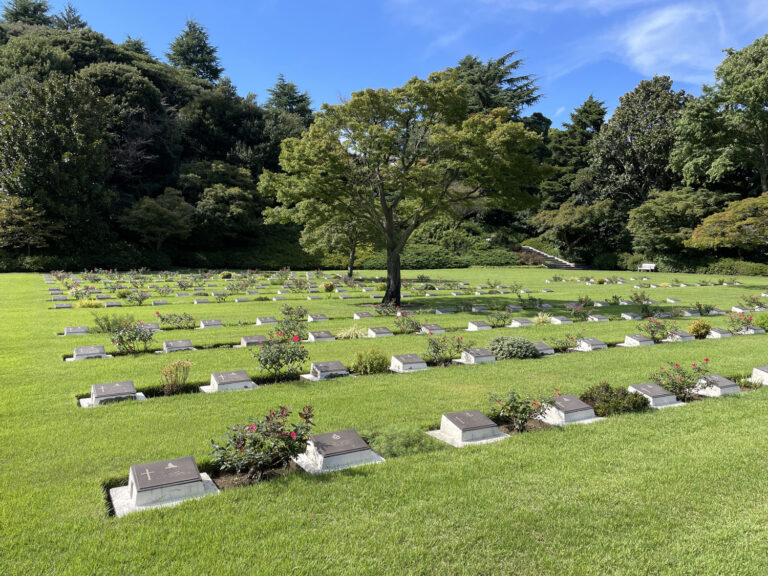Residents and visitors alike will be familiar with the Yokohama Foreign General Cemetery. Perched precariously on the Yamate-chō cliff and tumbling down the steep slope to Motomachi, it provides one of the city’s most iconic vistas. Innumerable snapshots of the harbor and downtown area feature gray headstones and white crosses in their foregrounds. Its origins date back to 1854, when Robert Williams, a 24-year-old marine on Commodore Perry’s USS Mississippi, became the first foreigner to be buried in Japanese soil for centuries. While the grave of Williams was temporary, from 1861 over 5000 others have filled the 18,000 square meters, representing all the religions and nationalities of those whose lives ended in Yokohama. The atmosphere is anything but morbid: on a warm day under a bright blue sky, the view is beautiful, inspiring appreciation of our hometown’s history. The privately-operated cemetery welcomes visitors on weekend afternoons, as well as their voluntary donations to help maintain the grounds.
However, this famous landmark is not the only “foreign” cemetery in Yokohama. Another nearby graveyard is more forlorn, gloomy, and usually deserted. A short walk from JR Yamate Station brings you to the Negishi Foreign Cemetery, run by the city since 1902 but rarely used until the Yamate cemetery was rendered unusable by the Great Kantō Earthquake. While there are 1200 graves, only 160 have headstones, many with the grim date of death: September 1st, 1923. If you wander here, ponder these tragic tales of lives cut short.
As international trade expanded in the late 19th century, Chinese merchants and their families emigrated to Yokohama, eventually outnumbering all of the other foreign nationalities combined. In 1892 the Chinese community built a separate cemetery on the hill of Ōshiba-dai, near the border of Naka-ku and Minami-ku. The original building, Dìzhàng Wángcháo, is the oldest surviving example of non-Japanese architecture in the city, constructed by artisans from Guangzhou with bricks from Alfred Gérard’s factory in Motomachi Park. Yokohama city recognizes it as an architectural treasure. A tower topped by a high spire was added later, visible throughout the hilly neighborhood. Despite geopolitical tensions between the mainland and Taiwan, generations of both communities lie side by side without conflict.
These three “foreign” cemeteries have one common element: they include the graves of many Japanese, both the spouses of foreign residents and (in Yamate) members of the Christian churches which maintain sections for their congregations. The fourth cemetery, though, differs in this respect as in many others. The Yokohama Commonwealth War Cemetery honors over 2000 soldiers and sailors from Britain, Canada, Australia, New Zealand, and India who died during World War II, many in prisoner of war camps. Administered by the worldwide Commonwealth War Graves Commission, it is a dignified and solemn memorial in a quiet residential area of Hodogaya-ku. A carefully maintained green lawn, manicured daily by attentive groundskeepers, is surrounded by hills and trees (including some species native to the Commonwealth dominions represented). The atmosphere is quiet and respectful. While separate sections divide the graves by nationality, the area called “Undivided India” includes soldiers of the British Empire from regions that were later partitioned into India and Pakistan, lying next to each other in harmony equal to the Chinese cemetery. Ceremonies take place annually on Remembrance Day (marking the end of World War I on November 11) and ANZAC Day (April 25). A similar Remembrance Day memorial service, equally dignified, honors the French and Allied soldiers who lie in the Yamate ceremony. All are open to the public without regard to nationality.


